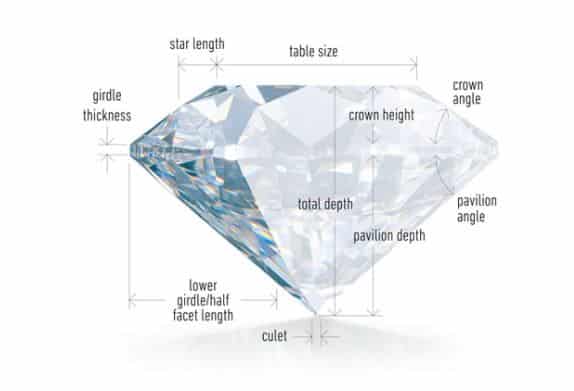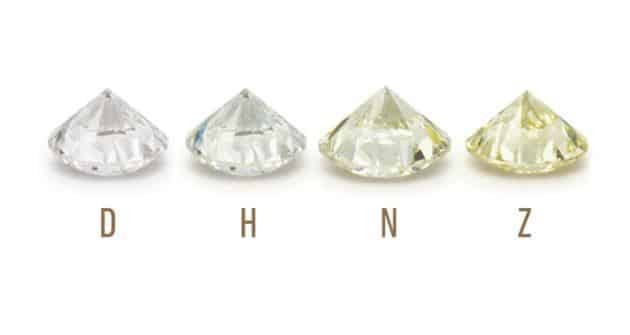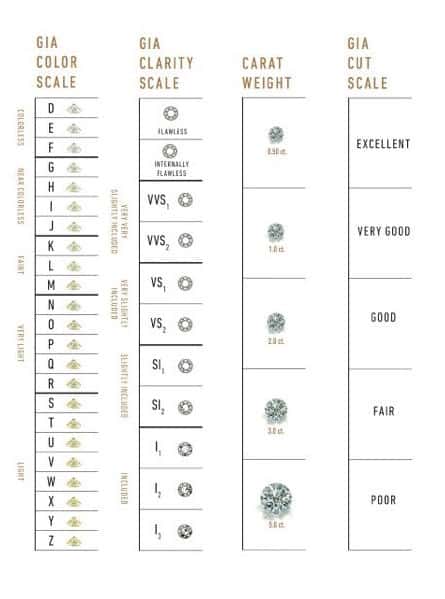The sparkling Diamonds are the hardest known substance on the earth. The jewel adorning gemstones vary in their physical features. While most diamonds might look quite identical, they vary in minor aspects from each other. You must have heard about the mysterious four Cs of the diamond. They are described as; Color, Clarity, Cut, and Carat. These four Cs give the diamond its unmatchable brilliant luster. You cannot make a perfect diamond with any individual C.
The Gemological Institute of America (GIA) introduced the first and universally adopted Diamond Grading Technique in 1953 for assessing the quality of the diamonds. The objective was to establish an undisputed, common language to describe the characteristics and features of a diamond. In 1955, the GIA introduced the diamond certificates that documented each diamond’s four Cs.
Another top-tier organization, American Gem Society (AGS) issues Diamond Grading Report that includes 4Cs, and Diamond Quality Report that gives a complete analysis of the diamond. These reports are helpful in evaluating the diamond for buyers and investors would know exactly what they are going to purchase.
Both GIA and AGS certificates are valid for assessing the quality of the diamond. And the scales of both organizations overlap with each other. The only difference is in the scaling of the Diamond Cut. The GIA describes the diamond cut as Excellent, Very Good, Good, Fair, and Poor. While AGS also ascribe a scales with it; from 0 (ideal cut) to 10 (Poor cut).
Grading reports reflect the quality of diamonds. Diamond sellers set their rates based on grading reports. Without a good proportion between the 4Cs, you will end up overpaying for specific facto. A diamond is valued for its quality cut with balanced color and clarity that enhances its beauty and brilliance.
DIAMOND CUT
The ‘Cut’ is the most significant characteristic of diamond integrity and elegance. Diamond cut is different from diamond’s shape. It refers to the symmetrical facets, angles, intersections, brilliance, sparkle, and reflecting finishing features of the diamond. A well-faceted, proportioned cut and polish affect its ability to transmit light. It increases the diamond’s brilliance and aesthetic attraction. This is unachievable with color and clarity of the diamond.
The GIA and AGS grade the diamond cut differently. AGS assigns a number to the descriptive grading of the GIA.
- 0- Ideal
- 1- Excellent
- 2- Very Good
- 3 to 4- Good
- 5 to 7- Fair
- 8 to 10- Poor
Achieving the artistic cut of the diamond is quite complex and technical. The cut is evaluated based on how it interacts with light to give a bright sheen. About 20% of the light immediately reflects off the surface, rest enters the diamond. A proportionately-cut diamond will allow maximum light reflection from the crown instead of bottom. This reflection is perceived as brightness, fire, and scintillation.
Brightness: The reflected Internal and external white light.
Fire: The scattering of white light into the rainbow colors.
Scintillation: the sparkle produced, and the pattern of light and dark areas caused by reflections within the diamond.
The cutting of the diamond results in the stone loss. Therefore, the pressure is on cutter to maintain a striking balance between cut, carat weight, and yield. A small well-cut round diamond costs more than other diamonds.

DIAMOND CUT IS DIFFERENT FROM DIAMOND SHAPE
Round Cut Diamonds
The most widely sold diamonds are of round-cut. These diamonds have been studied by gemologists more than any other variety. Distinguished for its unique fire and brightness, this 58-faceted diamond shows off outstanding light refraction. Where all else are comparable, round cut diamonds are more important than other shapes.
Heart Cut Diamond
The heart cut diamond has similar to love and admiration, making it a wonderful option for an anniversary or engagement ring. One of the most rigorous diamond cuts to establish, a heart-shaped stone needs great ability and mastery from the diamond cutter.
Pear-Cut Diamond
The pear shape diamond is brilliant-cut to compare with a drop of water. The result is a combination between a circle and a marquise cut.
Oval-Cut Diamond
A brilliant-cut, oval shape has almost the same level of gloriousness and fire as round cut. Due to its extended shape, the oval cut can seem bigger than a round diamond of identical carat (weight). The thinner the oval is, the more it appeals.
Princess-Cut Diamond
A stone with 90-degree intersections, the princess shape was created in the US in 1980. The vastly fancy-cut diamonds are flawlessly square. Some, however, are rectangular but it is hard to differentiate.
Asscher Cut Diamonds
This was introduced in 1902 by prominent diamond cutter Joseph Asscher, this diamond shape utilizes similar cutting as the emerald-cut but in square shape.
Radiant Cut Diamond
It is new to the jewelry industry; radiant diamonds were launched in a unique shape. This unique shape is an extraordinary combination of conventional round cut and an elegant emerald cut.

DIAMOND COLOR
The color evaluation of the gemstones is based on the presence or the absence of the color. Diamond Color is judged in terms of how white and colorless a diamond is. Pure diamonds are colorless. Before universalized grading method, the diamond color property was loosely classified as A, B, or C. The GIA , gave it a fresh start, from D to Z in alphabetical order. D characterizes the lucid and colorless diamonds. And lower grades up to Z indicate the brown or yellow tint. These color distinctions are very fine. You might need a diamond expert to evaluate the difference as it would definitely affect the cost.
The scales of GIA (alphabetic) and AGS (numeric) again overlap in grading the color of the diamond. These can be matched as follows;
| GIA | AGS | COLOR |
| D-F | 0.0-1.0 | Colorless |
| G-J | 1.5-3.0 | near Colorless |
| K-M | 3.5-4.5 | Faint |
| N-R | 5.0-7.0 | Very Light |
| S-Z | 7.5- 10.0 | Light |
DIAMOND CLARITY
A Diamonds Clarity refers to how eye-clean a diamond is; the presence of inclusions (internal imperfections) and blemishes (external imperfections) or lack of them within or on the diamond. Diamonds without imperfections are rare. These are introduced in the crystal structure during the geomorphic processes (under high temperature and pressure) when small crystals get trapped in it. They induce the structural irregularities. The size, position, and darkness of defects can obstruct light passing through the diamond. This affects the brightness and elegance of the diamond. Diamond cutters put grate effort in masking any blemishes or inclusions. Excellent grade diamonds are exceptionally flawless and rare.
Clarity is graded as follows;
| AGS | GIA | WHAT IT MEANS |
| 0 | FL (Flawless) or IF (Internally Flawless) | No inclusions or blemishes; extremely rare. |
| 1-2 | VVS1 (Very, Very Slightly Included 1) or VVS2 (Very, Very Slightly Included 2) | Slight inclusions; difficult to see under 10X magnification; VS1 visible from Pavilion and VS2 from Crown. Invisible to naked eye. |
| 3-4 | VS1 (Very Slightly Included 1) or VS2 (Very Slightly Included 2) | Minor inclusions; under 10X magnification on close inspection. |
| 5-6-7 | SI1 (Slightly Included 1) or SI2 (Slightly Included 2) | Noticeable inclusions under 10X magnification on close inspection. |
| 7-8-9-10 | I1 (Inclusions 1) or I2 (Inclusions 2) | Obvious inclusions visible to naked eye. |
The slightly varying inclusions cannot be differentiated without expertise or with a naked eye. To a layman, the VS2 or SI2 would be eye-clean but they are quite different. Only an expert can accurately evaluate the clarity of the diamonds.
DIAMOND CARAT
The carat is the diamond’s material weight scaled in metric carats. One carat equals 1/5 gram or 0.2 grams. And it is subdivided into 100 degrees. Carat weight is the most accurate degree of the 4Cs. Carat weight is an ingredient to deem when buying a diamond. Two diamonds with same carat weight can have different sizes depending on diamond’s shape and cut. Therefore, the carat weight should hold more importance than overall impression and brightness.
Diamonds are priced based on the carat weight. Even if an increase in carat might not increase the size of the diamond; it definitely adds zeros to the right side of the amount. Further read: difference between carat and karat.
CERTIFICATE
An additional fifth C is used for Certificate or Confidence. It is your guarantee that a diamond’s 4 Cs have been confirmed by a reputable laboratory. Since anyone can print an invalid certificate and offer their opinion on the grade of a diamond, the certificate must come from a well-known independent laboratory like the GIA (Gemological Institute of America) and AGS (American Gem Society).
Each of the 4 C’s participates in the comprehensive elegance of a diamond and gives rise to unique stone features. You can obviously adjust the scales up and down for one C or the other as per your budget. You can either go up on the clarity scale for the maximum brilliance or down on G-J color scale for same carat weight. The diamond cut, however, is most critical. A precise cut gives any diamond its sparkling luster. And that’s what diamonds are loved for.
Taking everything into account, this guide provides a comprehensive insight to what the 4Cs of the diamond means. So that the next time you go on a diamond-hunt for your loved ones, you’d know what you are paying for.

